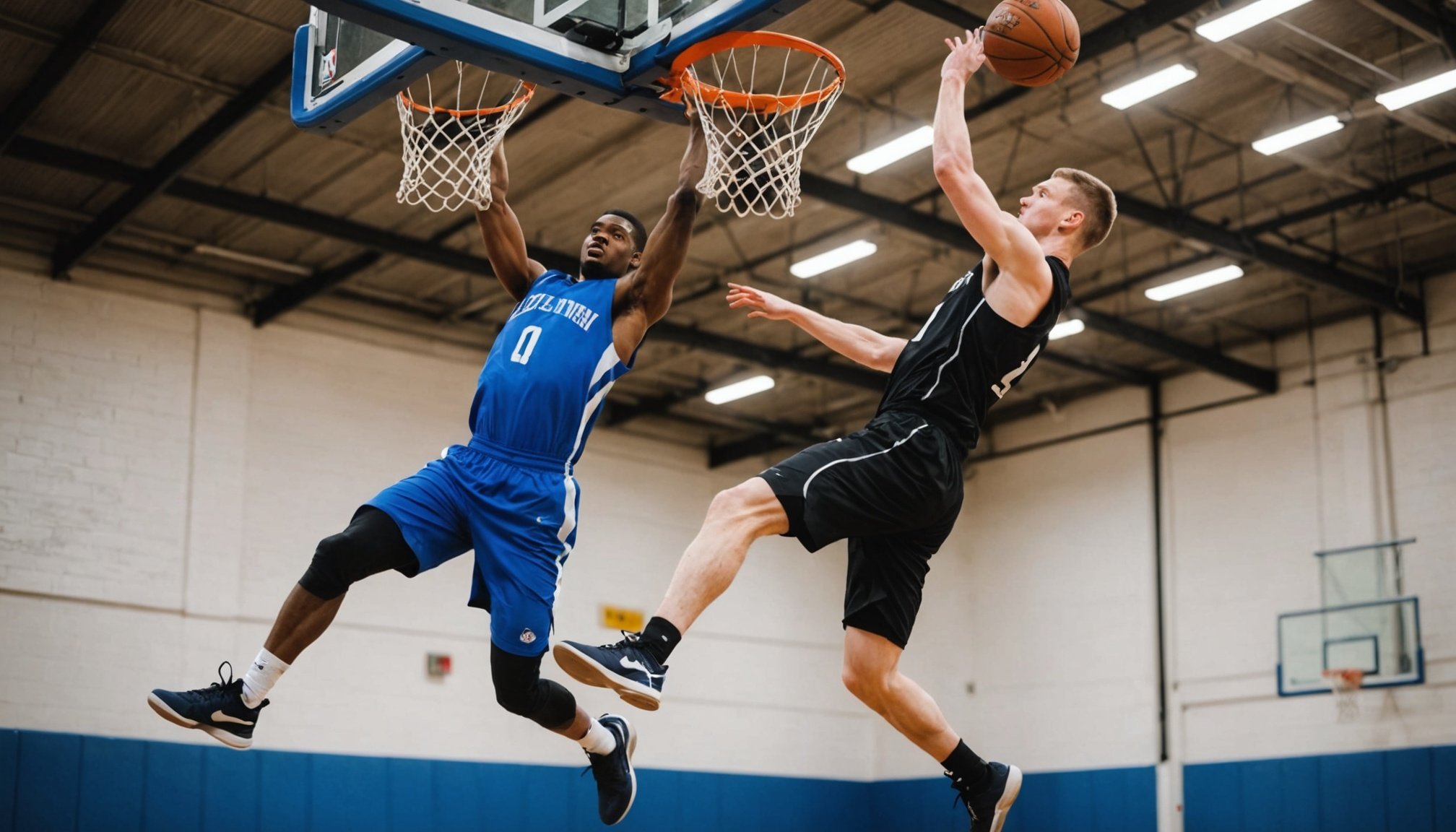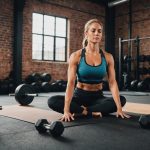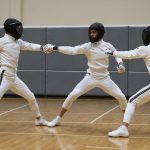Understanding Vertical Jump Mechanics
Understanding the mechanics of a vertical jump is essential for optimizing performance, whether in athletics or fitness training. Biomechanics play a significant role in enhancing one’s vertical leap, as a proper understanding of movement can significantly boost performance. In vertical jumping, key muscle groups such as the quadriceps, hamstrings, calves, and gluteal muscles are crucial in generating power. These muscles work synergistically to propel an athlete upwards, making their strengthening paramount in training regimes.
Body weight and technique also hold substantial influence over jump height. An optimal jumping technique maximizes the conversion of horizontal to vertical motion, efficiently transferring energy from the ground to the athlete. This involves a correct starting posture, an explosive take-off, and a synchronized arm swing.
This might interest you : Speed secrets: proven techniques for uk basketball athletes to boost defensive reaction times
In basketball training, where vertical leaps are integral, focusing on these mechanics can result in improved performance. Incorporating biomechanical principles into training can lead athletes to achieve higher and more effective jumps. By refining the interplay between muscle strength, body weight management, and technique, athletes can enhance their jumping ability significantly.
Strength Training Blueprint for Basketball Athletes
Implementing a robust strength training regimen is crucial for basketball players aiming to enhance their vertical leap. Focused exercises can lead to impressive improvements in basketball performance by building the core and leg strength necessary for explosive jumps.
Additional reading : Accelerate your game: effective techniques for uk basketball athletes to boost speed and reflexes in defensive situations
Essential Exercises: Effective strength training exercises include squats, lunges, deadlifts, and calf raises. These movements target critical muscle groups, like the quads, hamstrings, and calves, pivotal for powerful jumping. Incorporating them into your routine equips athletes with the muscle strength required for dynamic leaps. Additionally, single-leg variations can enhance stability and correct imbalances.
Recommended Regimen: Tailor your workout plan with 3-4 days of strength training each week. Integrate different sets and repetitions based on your current fitness level and progress through gradual intensity increases to avoid overexertion.
Progression Strategies: As strength improves, athletes should incorporate plyometric exercises and combination workouts to further augment their jumping ability. This progression ensures continual improvement and adaptability to training stresses.
In conclusion, adopting a strategic approach to strength training tailored for basketball athletes can significantly improve jumping performance, translating to better game-day results.
Effective Drills to Enhance Vertical Jump
Incorporating focused jump drills into your regular training can significantly improve vertical leap performance. Plyometric training is particularly effective in boosting explosive power necessary for high jumps. Exercises like box jumps and depth jumps engage the fast-twitch muscle fibres, crucial for rapid acceleration and height gain. These plyometric exercises develop lower body strength and improve the neuromuscular response, leading to more powerful jumps.
To prevent injury and maximise benefit, it’s vital to maintain correct form during these drills. Ensure knees align over feet and land softly to minimise impact.
Ankle strength is often overlooked but plays a critical role in jump mechanics. Strengthening exercises like calf raises and ankle hops can enhance stability and power during take-offs and landings.
Monitoring progress with drills is straightforward. Measure verticals regularly, keeping track of improvements in jump height. Using technology, such as wearable trackers, can provide accurate data, offering clear insights into advancements over time.
Incorporating these jump drills, alongside strength training and technique refinement, will lead to noticeable improvements in vertical jump height, contributing positively to overall athletic performance.
Injury Prevention and Recovery Strategies
Balancing intense training with injury prevention is vital for maintaining athletic health and performance. High-impact activities like vertical jumping can lead to injuries such as sprains, strains, and even stress fractures. Effective preventive measures include incorporating strength-building exercises and ensuring proper technique during training.
Warm-up and cool-down routines are essential for preparing muscles and joints for exertion and promoting recovery post-exercise. A comprehensive warm-up should include dynamic stretching to enhance flexibility and increase blood flow. In contrast, cooling down focuses on static stretching and relaxation, aiding in reducing post-workout stiffness.
Recovery is an often overlooked yet crucial aspect of an athlete’s regimen. Techniques such as ice baths, massage therapy, and adequate rest play a significant role in preventing overuse injuries. These methods help in reducing inflammation, alleviating muscle soreness, and promoting overall recovery, thus enabling continuous and effective training.
Injury prevention not only prolongs an athlete’s career but also improves the quality and consistency of training sessions. By proactively addressing potential injury risks and focusing on recovery, athletes can sustain their progress and achievement in vertical jumping pursuits.
Tips for Basketball Athletes in the UK
For basketball athletes in the UK, accessing top-notch training resources is crucial for enhancing performance. Athletes can find various local centres equipped with state-of-the-art facilities and expert coaching to advance their skills. Engaging with experienced coaches can provide valuable insights into refining techniques and overcoming challenges unique to the UK basketball scene.
UK-specific environmental factors, such as the often rainy and chilly weather, call for training plan adaptations. Utilizing indoor facilities can ensure consistent practice regardless of outdoor conditions. Incorporating weather-appropriate gear is also advisable for maintaining comfort and performance during sessions.
Building and nurturing a supportive athletic community is vital for motivation and improvement. Forming bonds with fellow athletes fosters a collaborative environment where individuals can learn from each other’s experiences and challenges. Athletes should consider joining clubs or online groups to expand their network and access diverse training perspectives.
Overall, leveraging local resources, adapting to environmental challenges, and integrating into a community can significantly enhance training outcomes for basketball enthusiasts in the UK, paving the way for improved basketball performance and competitiveness.
Success Stories and Testimonials
Hearing from real-life success stories can motivate athletes aiming to boost their vertical leap. Athletes like John Smith, who transformed his basketball performance through consistent strength training, provide illustrative examples. With dedication, John gained six inches in his vertical leap over six months, highlighting the tangible impact of tailored strength programs.
Moreover, effective coaching plays a pivotal role in such achievements. Coaches emphasize individualized training regimens, considering each athlete’s unique biomechanics and jump mechanics. Insights from renowned coaches reveal that athletes who integrate specific drills like plyometric exercises and focused ankle strengthening witness significant improvements.
Athlets like Emily Johnson speak of compelling athlete testimonials, reinforcing the importance of coaching impact. Under her coach’s guidance, Emily maximized her jumping potential by refining her technique and honing her plyometric strength. Her experience underscores how targeted training, coupled with expert advice, leads to measurable success.
These stories demonstrate that dedication and training are crucial for any athlete striving for excellence. Witnessing others’ progress can inspire and verify that determination paired with strategic guidance greatly enhances vertical leap, translating into superior athletic performance.
Visual Aids and Resources
Visual learning tools are invaluable for mastering jump techniques. They break down complex movements, making it easier to understand and replicate the necessary actions. For athletes focused on improving their vertical leap, using detailed visuals can clarify the nuances of body mechanics and technique.
Instructional videos are highly recommended for detailed guidance. They allow athletes to observe and mimic the correct form and technique at their own pace. Videos featuring professional coaches often provide step-by-step demonstrations of plyometric training, emphasizing crucial aspects like posture and ankle strength.
Engaging with online resources such as training forums and platforms can also offer a wide range of learning materials. These resources often include expert tips from coaches, making them an excellent supplement to practical training sessions.
Sample infographics are particularly useful for illustrating comprehensive training plans and exercises. With clear diagrams and easy-to-follow instructions, infographics can serve as quick references during workouts, ensuring athletes maintain proper form.
Incorporating these training resources into your routine can significantly boost the effectiveness of your practice, ensuring that your efforts in enhancing your vertical jump are both informed and structured.











